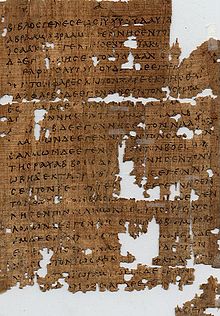Papyrus 1
From Textus Receptus
(→Text) |
(→External Links) |
||
| Line 20: | Line 20: | ||
* [http://en.wikipedia.org/wiki/Papyrus_1 Wikipedia article on Papyrus 1] | * [http://en.wikipedia.org/wiki/Papyrus_1 Wikipedia article on Papyrus 1] | ||
| + | |||
| + | [[Category:3rd-century biblical manuscripts|Papyrus 0001]] | ||
| + | [[Category:New Testament papyri|Papyrus 0001]] | ||
| + | [[Category:Oxyrhynchus papyri|Papyrus 0001]] | ||
| + | [[Category:University of Pennsylvania|Papyrus 0001]] | ||
Revision as of 11:25, 11 July 2009
Papyrus 1 (in the Gregory-Aland numbering) designated by![]() 1) is an early copy of the New Testament in Greek. It is a papyrus manuscript of the Gospel of Matthew dating to the 3rd century. It is currently housed at the University of Pennsylvania Museum (E 2746), and was discovered in Oxyrhynchus, Egypt.
1) is an early copy of the New Testament in Greek. It is a papyrus manuscript of the Gospel of Matthew dating to the 3rd century. It is currently housed at the University of Pennsylvania Museum (E 2746), and was discovered in Oxyrhynchus, Egypt.
Contents |
Description
The manuscript is a fragment of two leaves, one column per page, 27-29 lines per page, roughly 14.7 cm by 15 cm. The surviving text of Matthew are verses 1:1-9, 12 and 13, 14-20. It is dated paleographically to the early 3rd century. The words are written continuously without separation. Accents and breathings are absent. The nomina sacra written in abbreviated forms: ΙC XC YC ΠNA KΣ.[1]
Text
The Greek text-type of this codex is a representative of the Alexandrian text-type. Aland placed it in Category I.[2]
![]() 1 follows the text of Codex Vaticanus, from which it rarely varies.[3] Most of the variants are in the spelling of names in the genealogy.
1 follows the text of Codex Vaticanus, from which it rarely varies.[3] Most of the variants are in the spelling of names in the genealogy.
History
Bernard Pyne Grenfell and Arthur Surridge Hunt discovered this papyrus at Oxyrhynchus in Egypt, on the second day of excavation, in the Winter of 1896-1897. Their findings were published in the first volume of The Oxyrhynchus Papyri in 1898.
External Links
Facsimilies of P1 (large files, high resolution images):

